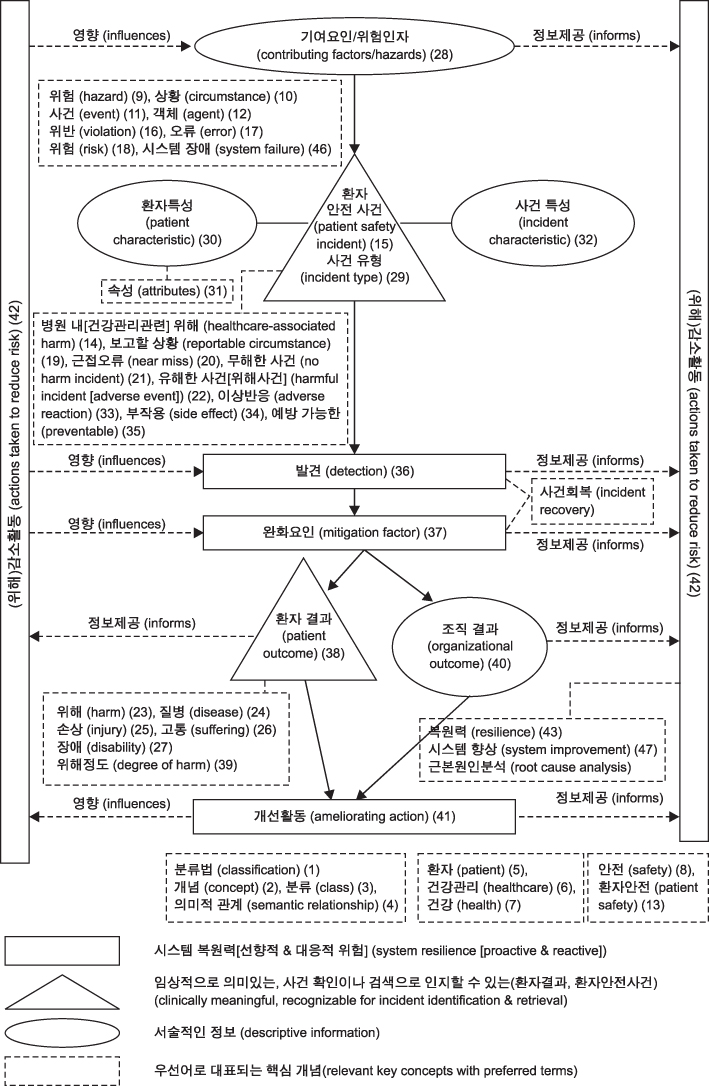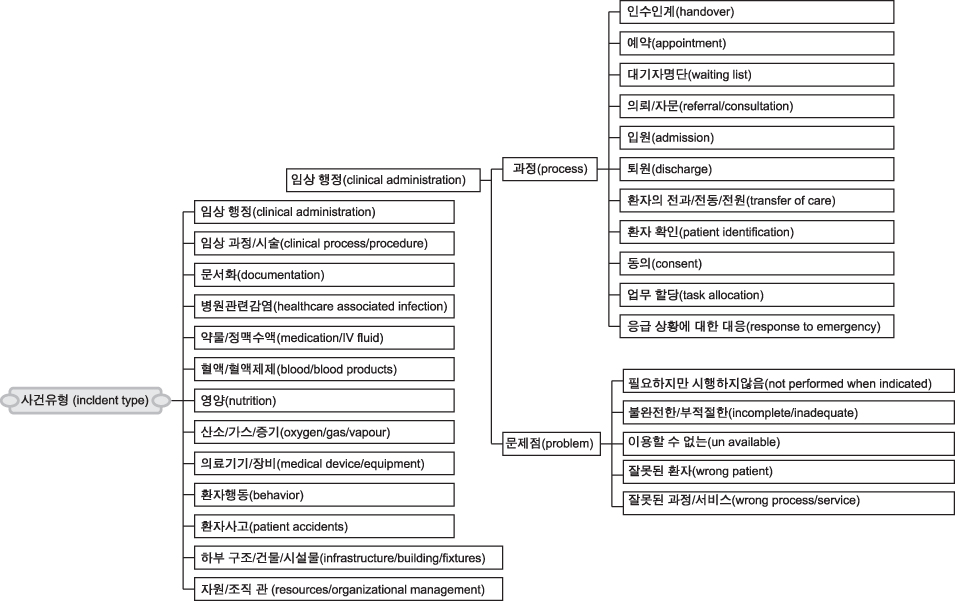J Korean Soc Med Inform.
2009 Dec;15(4):381-392.
A Korean Version of the WHO International Classification for Patient Safety: A Validity Study
- Affiliations
-
- 1College of Nursing Seoul National University, Korea.
- 2Research Institute of Nursing Science Seoul National University, Korea.
- 3Department of Emergency Medicine, Asan Medical Center, University of Ulsan College of Medicine, Korea. rufiji@gmail.com
- 4Nursing Department, Seoul National University Hospital, Korea.
Abstract
OBJECTIVE
The conceptual framework for the international classification for patient safety (ICPS) was released in January 2009. Since then, a Korean version of ICPS was developed. This paper describes the translation process and evaluates the validity of the Korean version. METHODS: Two research groups were involved in the development of the Korean version of ICPS. The draft of the Korean version was developed through intensive consultations with experts and extensive consensus building efforts. Subsequently, a modified Delphi method was used to develop the final version. Twenty-one experts, including professors in medicine and nursing, quality experts, and clinical experts, had been engaged in the process. A back translation was also done to evaluate the validity of the final Korean version. The level of agreement between the original version and the back translated version in terms of 48 key concepts was evaluated. The levels were classified as complete, partial, and no agreement. RESULTS: Thirty concepts (62.5%) agreed completely, 11 concepts (22.9%) agreed partially, and seven concepts (14.6%) had no agreement. Overall, the agreement between the original and the back translation was 85.4%. CONCLUSION: Because no standard classification currently exists for patient safety in Korea, this Korean version of ICPS can be used as a standard. However, the relevance and utility of this classification must be further evaluated through clinical field tests.
Keyword
Figure
Reference
-
1. Aspden P, Corrigan JM, Wolcott J, Erickson SM. Patient safety: achieving a new standard for care. 2003. Washington DC: National Academies Press;1–28.2. Kohn LT, Corrigan JM, Donaldson MS. To error is human: building a safer health system. 2000. Washington DC: National Academy Press;86–108.3. Sherman H, Castro G, Fletcher M, Hatlie M, Hibbert P, Jakob R, et al. Towards an international classification for patient safety: the conceptual framework. Int J Qual Health Care. 2009. 21(1):2–8.
Article4. Bates DW, Cohen M, Leape LL, Overhage JM, Shabot MM, Sheridan T. Reducing the frequency of errors in medicine using information technology. J Am Med Inform Assoc. 2001. 8(4):299–308.
Article5. Loeb J, Chang A. Report WHO HQ/03/116334. Reduction of adverse events through common understanding and common reporting tools: towards an international patient safety taxonomy. A review of the literature on existing classification schemes for adverse events and near misses. 2003. Geneva: World Health Organization.6. Kopec D, Shagas G, Kabir M, Reinharth D, Castiglione J, Tamang S. Errors in medical practice: identification, classification and steps towards reduction. Studies in health technology and informatics. 2004. 103:126–134.7. Donaldson SL. An international language for patient safety: Global progress in patient safety requires classification of key concepts. Int J Qual Health Care. 2009. 21(1):1.
Article8. Runciman WB, Williamson JA, Deakin A, Benveniste KA, Bannon K, Hibbert PD. An integrated framework for safety, quality and risk management: an information and incident management system based on a universal patient safety classification. Qual Saf Health Care. 2006. 15:Suppl 1. i82–i90.
Article9. Runciman WB. Shared meanings: preferred terms and definitions for safety and quality concepts. Med J Aust. 2006. 184:10 Suppl. 43–44.
Article10. Elder NC, Pallerla H, Regan S. What do family physicians consider an error? A comparison of definitions and physician perception. BMC Fam Pract. 2006. 7:73.
Article11. Kim EK, Kang MA, Kim HJ. Experience and perception on patient safety culture of employees in hospitals. J Korean Acad Nurs Admin. 2007. 13(3):321–334.12. Kim SW. Patient Safety: a new standard of care. J Korean Hosp Assoc. 2006. 35(9):87–96.13. Um YR. Disclosure of unanticipated outcome information as a strategy of patient safety. J Korean Bioethics Assoc. 2005. 6(2):11–29.14. World Health Organization Alliance for Patient Safety. Project to develop the international patient safety event taxonomy: updated review of the literature 2003-2005. 2005. Geneva: World Health Organization.15. World Alliance for Patient Safety. WHO draft guidelines for adverse event reporting and learning systems: from information to action. 2005. Geneva: World Health Organization.16. Woods DM, Johnson J, Holl JL, Mehra M, Thomas EJ, Ogata ES, et al. Anatomy of a patient safety event: a pediatric patient safety taxonomy. Qual Saf Health Care. 2005. 14(6):422–427.
Article17. Chang A, Schyve PM, Croteau RJ, O'Leary DS, Loeb JM. The JCAHO patient safety event taxonomy: a standardized terminology and classification schema for near misses and adverse events. Int J Qual Health Care. 2005. 17(2):95–105.
Article18. Runciman W, Hibbert P, Thomson R, Van Der Schaaf T, Sherman H, Lewalle P. Towards an international classification for patient safety: key concepts and terms. Int J Qual Health Care. 2009. 21(1):18–26.
Article19. December 12, 2009. Available at: http://www.who.int/patientsafety/taxonomy/icps_form/en/index.html.20. December 12, 2009. Available at: http://www.who.int/patientsafety/about/wha_resolution/en/index.html.21. December 12, 2009. Available at http://www.who.int/patientsafety/taxonomy/reports/en/index.html.
- Full Text Links
- Actions
-
Cited
- CITED
-
- Close
- Share
- Similar articles
-
- Validity and Reliability of the Korean Version of the Women's Toileting Behavior Scale
- Validity Assessment of the Persian Version of the Nordic Safety Climate Questionnaire (NOSACQ-50): A Case Study in a Steel Company
- Validity and Reliability of the Korean Version of Advance Directives Attitude Scale for Nurses
- Validity and Reliability of Korean Version of Assertiveness Scale for Nurses (K-ASN)
- Korean Version of the Revised UCLA Loneliness Scale: Reliability and Validity Test




